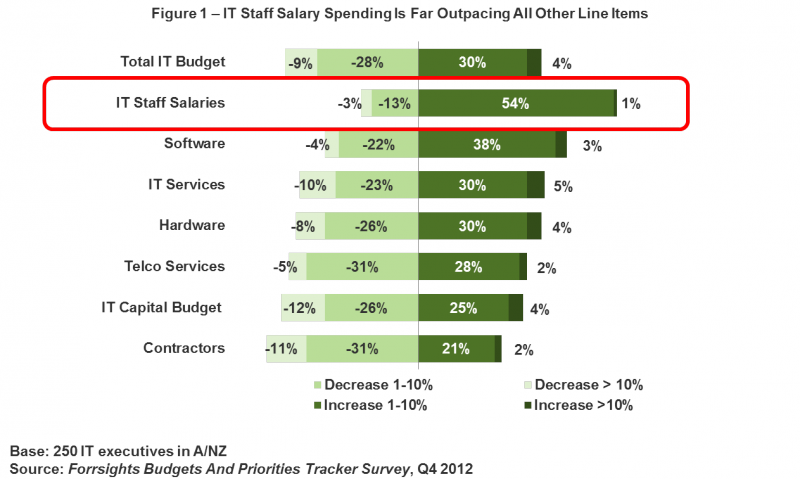IT Salaries in Australia and New Zealand – Paying A Premium for Value
In Q4 2012, Forrester interviewed over 2,800 senior IT and business decision-makers across Asia Pacific, including 250 senior IT decision-makers with budgetary authority in Australia and New Zealand (A/NZ). Respondents included a mix of small and medium-sized businesses (SMBs) and large organizations, with all major vertical market segments represented. On average, 6% of A/NZ respondents’ total budget is currently spent on IT (including both operating and capital budgets). Of that total IT budget, an average of 26% is targeted at new initiatives, versus 52% targeting ongoing operations and maintenance and 22% targeting capacity replacement & expansion.
While these findings are interesting, the expected spending on IT staff salaries is what really stands out. Our Forrsights data shows spending on IT salaries in A/NZ rising far faster than all other IT-related line items (see Figure 1). This is not an anomaly. In fact, it’s a sign of things to come.

There are several likely reasons for this dynamic:
- The types of IT skills in demand continue to shift. A/NZ organizations are increasingly focused on outcomes, which has shifted demand away from base level administrators and technical staff in areas like application development and support, or infrastructure and operations. These capabilities are increasingly being outsourced or are sourced via as-a-service approaches. Instead, organizations are addressing a need for fewer, but more expensive staff with specialized, business-focused skills in areas like strategy, architecture, sourcing and vendor management. Put another way, the cost per senior IT staff is rising in response to business demands for greater value and improved service delivery. So while the numbers of IT staff remains flat for many A/NZ organizations (or even decreasing slightly), the spending on IT staff salaries is rising.
- A major shift in contractor relationships is underway. In the early 2000's we saw the use of high cost contractors in senior positions such as architects, project and program managers, strategists etc. Organisations are now increasingly likely to contract out lower paid positions and retain higher paid positions in preference. This is largely a response to the recognition that high value contractors can potentially put organisations at risk with the loss of capability when they leave. This is particularly true where there is very little knowledge transfer or capability building, with consultants focused only on "getting things done" and then departing. This shift in priorities is illustrated in Figure 1, with spending on contractors growing slower than any other IT line item.
Just like their counterparts in North America and Western Europe, IT organizations in Australia and New Zealand are facing strong business pressure to improve operational efficiency and increase responsiveness to business demands. In many instances, this pressure is matched only by the demand to reduce spending across software, hardware and services. To address this challenge, Forrester expects spending on IT staff salaries to continue to rise, particularly as the skills in demand increasingly come at a premium.
Dane Anderson, John Brand, and Tm Sheedy all contributed to this blog post.
